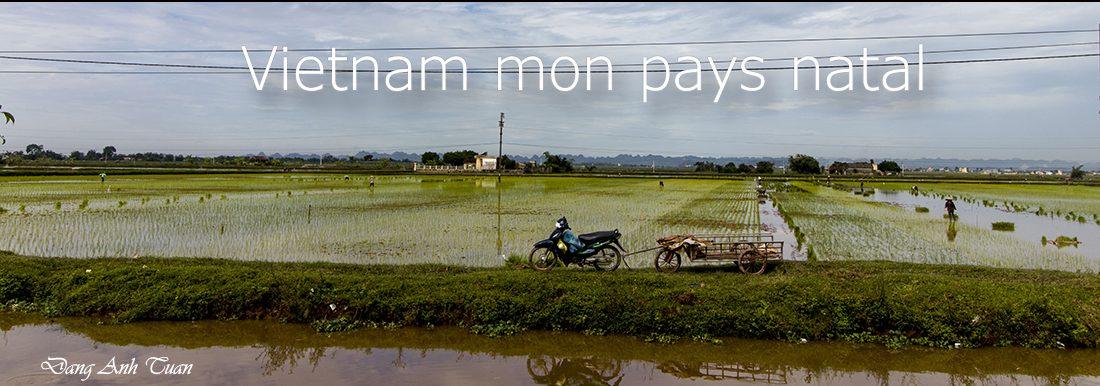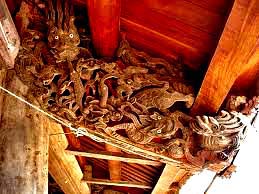Communal house
Its construction is always operated according to a well-defined layout plan identifiable by some Chinese characters Nhất, Nhị, Tam, Ðinh, Công, Vương etc. . A communal house (đình) who stands alone with a rectangular main building (đại đình) evokes the character « Nhất ». This is the case of « đình » Tây Ðằng.
By contrast, we are led to recognize the character Nhị by adding to the main building a second building (tiền tế) (or building reserved for sacrifices). This one is parallel to the first building and preceding it in the new layout. This is the case of the communal house Liên Hiệp. It is rare to find the character Tam in the construction of communal house. In a general way, the « đình » is frequently encountered in the shape of the character Công.
The posterior building Hậu Cung is connected to the main building by a small corridor or a small court (Ống muống) . This is the case of the communal house Đình Bảng, Mộng Phụ. For the character Vương, it is sufficient to connect three buildings (Hậu Cung, Đại Đình, Tiền Tế) with two corridors (Ống muống). It is in this last building « Tiền Tế » where the official ceremony for tutelary genius is performed by notables wearing a blue suit during the feast days.
Decoration art in the communal houses
Thanks to the communal house (đình), we discover that the village life is intimately introduced in the decoration art. This one tries to liberate itself not only from classic conventional models encountered until then but also Confucian straitjacket that Vietnam has known in the feudal system. That is what we see in wooden carvings which take up all free spaces encountered inside the đình (from roof frame to columns).
All imperfections of the construction are hidden with address thanks to the technique of embellishment. In each carved piece, the motif whether it is animal, character, flower etc. .. is unique and cannot be found anywhere else even if it is the same theme. By contrast, one discovers in these sculptures the coexistence through centuries of two cultures, one being national and scholarly and the other popular. One finds not only in the first all motifs relating to four hieratic animals (Rồng, Lân, Rùa, Phượng) (Dragon, Unicorn, Tortoise, Phoenix), four noble plants, fairies, animals (tigers, elephants etc ..) but also fantasy, imagination, innovation from peasant-sculptor despite his strict obedience to etablished standards. In the popular sculptures, the master craftsman who is, above all, a peasant, let himself be guided by his personal inspirations, his sincere emotions, his frustrations, his spontaneity and his sentiments in the realization of his work with realism and humor. He succeeds in escaping the censoring custom by a unusual aptitude in the description of bawdy scenes through his work of art: a naked young girl taking a bath in the lotus pond or sitting with low-necked dress on a a dragon head (đình Phụ Lão, Bắc Giang) , a young man groping the body of a woman under the watchful eye of his partner (đình Hưng Lộc), a mandarin disturbing a girl who is obliged to hide her body with the lotus sheet in her bath ( đình Ðệ Tam Ðông, Nam Ðịnh) etc …
He dares to denounce the wrongdoings of corrupt mandarins. That is what one sees in the carved piece of the communal house Liên Hiệp. These are taboos and frustrating redtapes encountered every day in the Vietnamese confucian society. Everything found in this popular sculpture largely reflects artist’s freedom of expression, common aspirations and social life of village. The paradox is visible because the communal house is both the garden of Confucian order which is well established in Vietnamese family and social structure and the place where the peasant can find again his freedom of expression and denounce the Confucian straightjacket. By its sculptures and its architecture, the communal house constitutes an inestimable jewel for Vietnamese people. One has the habit of saying in Vietnamese: làng nước ( Village Nation ) because Vietnamese nation is constituted over centuries by the dissemination of villages whose communal house (Đình) is both spiritual, administrative, social and cultural centre. As a consequence, the communal house (Đình) is not only the soul of village but also that of Vietnamese nation.

